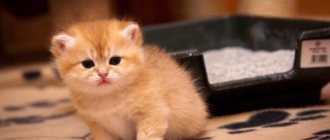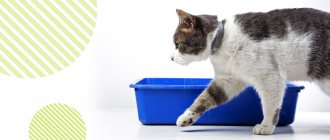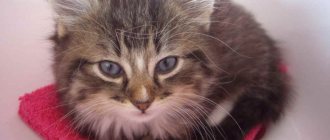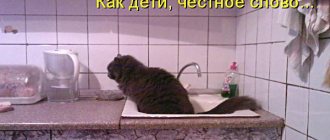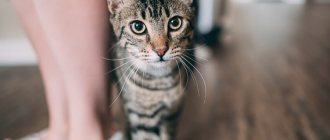Buying a tray
Before you train your cat to use the litter box, provide her with a comfortable toilet
. Important criteria when choosing a tray are:
- Size. A large animal will not fit in a small tray, and as a result, not all excrement will end up in the right place.
- Side height. Before going to the toilet, cats dig a hole, and then reflexively bury feces. It is impossible to wean a furry one from these movements. The only way out is a toilet with high walls (preferably with removable sides, rounded inward).
At what age is it best to potty train a kitten?
The golden rule: the sooner you start, the better. No one has canceled muscle memory. Of course, this refers to the period when kittens are ready for independent life - this is approximately three months or 12 weeks.
A positive point for the pet owner is that if the cat is litter box trained, the kittens will learn too, just wait.
As a rule, a kitten that comes into a home from a breeder has all its vaccinations, is healthy and socialized, and is already litter-trained (if it is 12 weeks old).
If you adopted a wild kitten from the street, do not despair. Check your health status, any difficulties with the genitourinary system and start training - it will be easier than with an adult animal. It is difficult to teach a cat without toilet skills, but it is possible even in cases where the animal basically shits everywhere.
Types of structures and their features
Depending on the design, all cat litter is divided into three categories:
- regular trays;
- closed trays covered with a dome;
- high-tech toilets.
Conventional trays are rectangular structures without any special frills or tricks. These include:
- Plastic toilets with low sides. They are ideal for kittens, attractive due to their low cost and ease of care. Among the disadvantages are poor odor retention, the need for filler and scattering of the latter throughout the surrounding area.
- Mesh toilets. A similar design, but a mesh is placed on top of the bowl. Feces flow through it, leaving your furry friend's paws clean and dry. The advantages are obvious: the toilet does not need litter, the paws are clean (important for pets who love to bask in their owners’ bed), and it is convenient to clean up excrement. Not all cats approve of the lack of litter, and you will have to think about how to accustom your cat to a litter box.
- Structures with high sides. They take up more space, but do not allow your pet to scatter the filler.
Enclosed litter boxes can cost ten times more than regular ones. The high cost is justified by a considerable list of advantages: aesthetics, odor retention, prevention of scattering of filler. Cats like the designs; they allow the animal privacy. Not all furry friends like the “front door,” so owners often remove it. Some cats regard the litter box as a home.
Automatic designs are even more expensive. This is a unique complex that itself adds filler and removes feces. At a given time, a screen driven by an electric motor sifts the litter and places the excrement in a special compartment, from where it is easily removed. It's convenient and hygienic. However, the unit may turn on when the cat relieves itself. Due to stress, a four-legged cat may refuse such a toilet, and the owner will have to think about how to accustom the kitten to the litter box.
How to become an authority for your pet
Cats understand human emotions well and know how to manipulate. Do not follow your pet's lead: the kitten must know that you are the leader in your territory. It is important to define rules of behavior and constantly follow them.
Cats do not live in packs and do not follow a leader. The main incentive for them is profit. Let the kitten understand: you are a source of affection, communication, treats - your rules should be followed. Otherwise, it won’t be long before you lose these pleasures.
Establish a good, trusting relationship with the animal. Pay attention not only to education and character formation. Your kitten needs to feel confident in your home. Provide him with a feeling of safety in communicating with people and a secluded place to relax. Remember to pay enough attention, but also respect personal space. A cat, like a person, periodically seeks to be alone.
What types of fillers are there?
The next stage is the choice of filler
. Only after purchasing it should you think about how to train a kitten to use the toilet. Fillers are divided into two groups: absorbent and clumping.
Absorbents include:
- Woody
. These are sawdust compressed into granules, which are destroyed after absorbing water. It makes sense to use them in trays with a mesh - small wet sawdust spills to the bottom, and clean granules are suitable for use. Pros: low cost, safe and environmentally friendly, flushable down the toilet, ideal solution for small kittens. Cons: abundant distribution around the tray, poor odor neutralization. - Mineral
. Most of all they correspond to the cat's ideas about the toilet, but, unlike arboreal ones, they cannot be swallowed. Pros: accessibility, good absorbency. Disadvantages: if eaten, they can cause intestinal obstruction, they are easily spread throughout the apartment, and cannot be thrown into the toilet. - Silica gel
. They look like opaque light balls. Their characteristics are similar to those described above, but they absorb more moisture. The granules look unusual and make a strange sound under the pet’s paws, so many people don’t know how to train a one-month-old kitten to use the toilet. Pros: hypoallergenic, economical packaging, retains odors well. Disadvantages: high cost, likelihood of a chemical burn if it gets on the mucous membrane.
Clumping fillers are also represented by wood
and
clay
options. They do not absorb moisture, but bind water through a chemical reaction, forming lumps. Wooden (Cats Best) litters are well suited for small kittens, but they quickly spread around the apartment. For this reason, clay clumping litters (Clean Paws) are purchased for adult cats. They are economical, non-toxic, and do not settle as much on the paws of animals. This option is not suitable if several pets use the litter box. They will quickly break up the clumps and the entire litter will turn into a messy mixture.
Choosing toiletries for your furry pet
If the decision to get a kitten or an adult cat was not made spontaneously, then you need to stock up in advance on the necessary things required for the normal maintenance of the animal.
Need to purchase:
- tray;
- filler.
You must purchase the tray and filler in advance
In addition, you will need to decide on the location of the pet’s toilet.
Selecting a tray
In pet stores you can see a very large number of trays, differing in design, size and construction. The most common and popular are plastic products. They are inexpensive, easy to clean, and come in a variety of sizes and colors. Plastic modifications of pots with mesh are offered, which do not require filling. There are closed-type options, which are kind of small houses. But caring for such pots is much more difficult.
Trays vary in size and height
The most expensive and modern trays include automatic pots. Maintenance of such structures is minimal, and they look very attractive. The main disadvantage is the high price.
Automatic cat litter box requires virtually no maintenance
For a small kitten, a not very large tray with low sides (5–7 cm) is suitable, otherwise the baby simply will not be able to climb into it. But if the sides are too low, then when the pet begins to diligently bury its feces, some of the filler will always fall out onto the floor. When the kitten gets a little older, you can offer him a tray with a more spacious design.
A toiletry product for an adult animal is chosen based on the size of its body. A large individual will need a large and deep tray. A smaller cat may need a smaller pot.
If the space allows, you can purchase a closed tray for your pet.
It is important that the entire structure is stable. A cat that is too light may accidentally knock over a tray when it steps on its edge. Subsequently, the pet will be afraid to go there.
From personal experience. We adopted an adult cat for foster care. The owners brought it along with their own toilet, litter, bowl and other household items. The tray was placed next to the existing one. Coincidentally, the filler turned out to be the same, and the nosy cat immediately climbed into our cat’s potty. But she is very tiny, and her tray is also very small. The guest in it was barely able to turn around, almost knocked him over and didn’t go there again.
Selecting filler
Cats are picky eaters and they all like different types of litter. When choosing a composition for a kitten, you need to focus on the type that was used in the pot of its parent. The familiar smell will attract the baby there. If he was picked up on the street or is not yet toilet trained at all, then you should opt for safe wood pellets.
For small kittens, it is recommended to fill the pot with safe wood filler.
For adults, a gel or silicone filler is suitable. But not all cats like the crunch that occurs when walking on such granules. It is not recommended to use these varieties for kittens, as babies may accidentally swallow the gel balls. When they enter the gastrointestinal tract, they increase in volume many times over, which can lead to intestinal obstruction.
For adult cats, silica gel litter is recommended.
Clumping material is very convenient because it does not require frequent replacement. It is enough just to periodically remove the formed lumps. Clay mineral compositions are highly absorbent, so they are chosen for very large cats or if there are several mustachioed pets living in the house.
There is no need to frequently change the entire filler; it is enough to remove the formed lumps
A good filler should be safe, absorb liquid well, and also retain unpleasant odors. In addition, it should not itself have a strong aroma that could scare away the animal.
Choosing a place for the toilet
It is extremely important to choose a calm, quiet and non-traffic area for the cat's litter box. The animal needs peace and solitude while performing its natural needs. He should not be disturbed by his owners or other animals. Your pet will also feel uncomfortable near noisy household appliances.
The place for the tray should be quiet and secluded
You should not place a potty next to food and water bowls, as cats do not like to defecate where their food is. The ideal place is a bathroom, toilet room or closet. The door must be open at all times so that the animal has easy access to its toilet.
If there are several cats living in the house, it is recommended that each animal have its own individual toilet.
Tips for the owner
Do not forget about the rules for using fillers:
- Be wary of scented litters (your pet may not like the smell).
- The filler layer should be as thick as possible.
- The scoop is selected based on the type of sand. You should be able to reach all the way to the bottom with the scoop and run it along the bottom. The size of the cells should allow grains of filler to spill freely through the scoop.
- Don't change the litter if your cat likes it (or do it carefully, otherwise she may stop using the litter box).
Kitten care
To take care of your pet's health, it is important to clean his litter tray regularly. First of all, this is necessary in order to get rid of the unpleasant odor, because when you change the filler, it does not go away anywhere.
To simplify the task for owners, a special tool for training a kitten to the tray called “Smart Spray” will help.
In addition, if hygiene measures are not followed, other problems may arise:
- Formation of urinary stones. This is the main reason for bad smell in the room. The plaque is easily washed off; different detergents are used for this. The tray should be thoroughly rinsed under water to prevent any chemical smell remaining.
- Toxoplasmosis. This disease is caused by single-celled parasites that are found in cat feces (if the animal is infected). If you do not promptly clean the tray from feces, a person may also suffer from this disease. For a pregnant woman, the disease is especially dangerous.
By nature, cats are very clean animals.
To prevent these problems from occurring, it is recommended to clean the litter box after the kitten has used it, and change the filler every 3 days.
Your kitten will grow up quickly, and if one day the tray turns out to be too small for him, the pet can go around the house looking for a larger toilet.
To ensure that the tray is always in good condition, you must adhere to the following rules:
- faeces must be removed immediately;
- you should choose trays from high-quality material;
- use high-quality filler;
- Regular cleaning of the tray.
Not every pet owner has the opportunity to wash the litter box after each bowel movement, so you can use special products in the form of sprays and special balls.
Silica gel cat litter cannot be flushed down drains like wood litter and can only be disposed of with household waste.
Love and patience are the main points that will help in such a difficult question as teaching a small kitten to go to the toilet. Do not forget that in the first days of a kitten’s stay in the house, it must be surrounded with attention and care.
It is important to provide the baby with complete comfort in his sleeping corner by placing a soft toy or a warm heating pad there, and to treat him during this period with special tenderness and care.
How to toilet train a cat?
In a new home, the animal should initially be limited geographically to one room. This makes it easier to watch the baby. During the first 24-48 hours, the kitten gets used to its new home and usually does not go to the toilet.
How to train a cat to use the litter box quickly? You should:
- Place the pot in a secluded place.
- Place the kitten in it, scratch it with its paw along the sand (or along the walls of the tray, if you want the pet to go to the toilet without litter). Repeat the procedure every 2-3 hours (in the morning, after meals, before bed).
- After relieving himself, praise and stroke the fluffy.
If you notice that the animal is resting in the “wrong place”, make a sharp sound (clap), take the kitten and place it in the tray. If after work a “surprise” awaits you in a secluded corner, blot the liquid with a napkin and place it in the tray. The animal will follow the smell. Under no circumstances should you scold or beat him. This will worsen the situation and your pet will begin to fear you.
How to toilet train an adult cat? If she sees the tray for the first time, she should like it (it should be spacious, deep and comfortable). If you adopted your pet from friends or a shelter, immediately upon arriving home, place it in a litter tray. The animal must intuitively understand that it needs to manage its affairs here. If it marks the wrong place, wash the marked areas with white, lay out orange peels, place bowls of food, try rearranging the tray, or buy a second one. Be patient and your efforts will be rewarded!
We train the cat to use the toilet
Wait until the kitten is 6 months old; after this age, the animal can safely perform the entire procedure in the toilet without using a tray. Also, make sure that the structure of your toilet is safe for the animal in case it accidentally falls into the water. If he can’t get out of the water easily enough, think about it: maybe you shouldn’t train your cat to use the toilet. Or use a special toilet nozzle sold in the store, more about it below.
- Start by moving the litter box to the toilet.
- As soon as the cat begins to constantly go to the right place, place a book or a stack of newspapers 2-3 cm high under the tray every 1-2 days in the first days, and then up to 5-8 cm per day.
- Thus, by about 10-15 days the tray will be at the height of the toilet. Leave the tray on the closed toilet lid for a couple of days.
- If the cat is used to going to the right place, periodically remove the tray, open the toilet lid and leave a little litter at the bottom (if provided for by the design).
- It will take some time for the cat to get used to the toilet and the absence of a tray. The training may take a week, or maybe 2-3 months. Be patient and don’t scold the cat for things that don’t work out right away. On the contrary, be polite and affectionate with him. He feels good and will be more willing to learn new things.
The corner of the litter box is an ideal place to place your cat's litter box. And for toilet training it is a mandatory and necessary condition.
Preparing for training
An important point before the training itself is to choose a tray of the correct shape and size, as well as the appropriate filler, which will be most comfortable for your pet and will not become a source of irritation in the future.
You should take into account the size of the tray itself and focus on the dimensions of the animal. At a minimum, your pet should have extra space so that he can turn around freely.
If the kitten is very small, you can temporarily limit yourself to a medium-sized container, because if you buy a tray for growth, the pet may feel restless and anxious and not go into it at all.
How to feed a newborn baby
An important aspect is to ensure the correct feeding schedule for newborn kittens who are left without a mother. In such cases, it is necessary to follow simple recommendations:
- It is convenient to feed a kitten with cow's milk from a pipette up to 8 times a day (the temperature of the mixture should not exceed 37 degrees). The temperature is checked by pouring a drop of milk onto the back of the hand;
- if the kitten has reached the age of 1 month, then for feeding you can use a regular bottle with a nipple;
- After each feeding of the newborn, it is recommended to massage the tummy to improve digestion (light strokes clockwise);
- A qualified veterinarian can create an individual diet that will help quickly establish the baby’s digestive process.
How to teach not to spoil furniture
The kitten does not spoil the upholstery out of mischief. He definitely needs to sharpen his claws. This way he relaxes, practices the skills of releasing his claws and cleans them of dead tissue. Therefore, it is important to choose a scratching post that suits your pet. Vertical or horizontal, free-standing or mounted on furniture - it all depends on the preferences of the animal.
Help the kitten understand the purpose of the scratching post. To do this, carefully take his front paws and place them on its surface. If the kitten continues to tear furniture and wallpaper, use special pads to protect them. Bedspreads or temporarily closed doors to a room with a favorite item are also suitable for this. Use special sprays to scare away furniture and attract attention to the scratching post.
How to change a kitten's diet
A variety of diet is provided gradually after the first three weeks of a kitten’s life, which helps improve the functioning of the digestive system, and the baby begins to enjoy eating food.
List of approved products for small kittens:
- low-fat kefir aged three days;
- smoked meats can be used as a flavoring additive to food to develop a stable reflex to food intake in an animal;
- liquid porridges, vegetable purees;
- boiled meat in small pieces.
If more than 5 months have passed since the birth of the kitten, then it can eat a variety of foods in normal quantities, like an adult animal. Mature individuals have well-developed digestion, teeth have formed, so they are completely ready for adult life.
How to stop aggression
The kitten is a predator; during play she tries to “hunt”. It is important to make it clear: claws and teeth cannot be used. The sooner you do this, the better. Bites and scratches from a baby do not cause much discomfort, but the claws of an adult cat can seriously injure. Never tease your kitten with your hands or feet. This provokes him to hunt them. If your pet bites or scratches, stop playing immediately. Speak to him in a stern, firm tone, but do not shout. When your pet arches its back, snorts, hisses, flattens its ears and wags its tail, it is angry and ready to fight. Distract attention with a loud, unexpected sound; in extreme cases, use a spray bottle of water. It is very important that the animal learns that aggression is not allowed.



